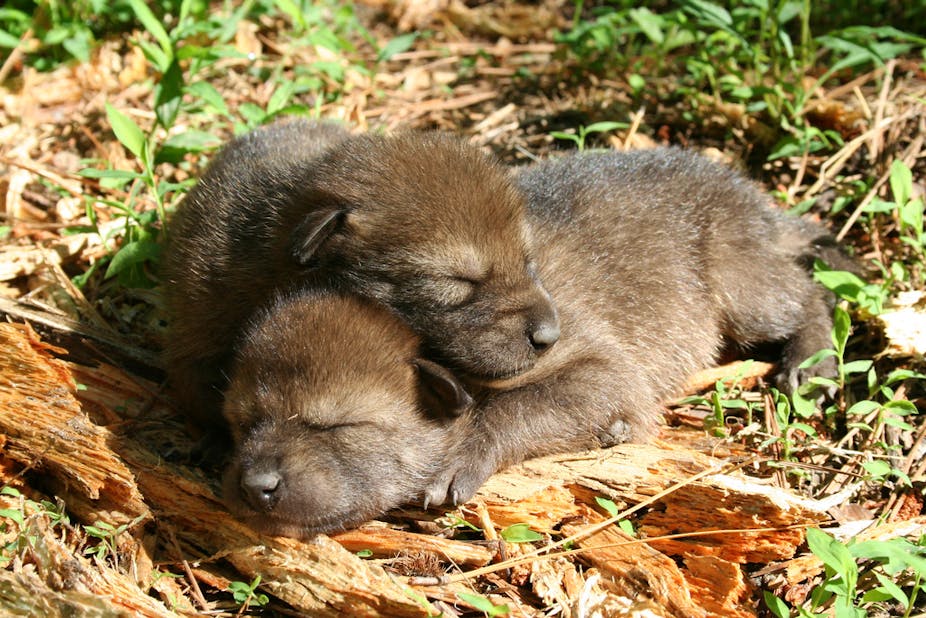Red wolves were one of the first carnivores Europeans encountered in North America. Unfortunately, this meant red wolves were also one of the first to be exterminated. Fuelled by fear and superstition, government supported eradication campaigns reduced red wolves to only about 100 individuals by mid-20th century.
In the 1970s, the US Fish and Wildlife Service (USFWS) removed the last remaining red wolves from eastern Texas and western Louisiana to try to save them in captivity. Declared extinct in the wild in 1980, the USFWS has since focused conservation efforts on creating a captive population from which to restore red wolves to their historic range in the future.
Now, despite reestablishing a wild population, the USFWS Red Wolf Recovery Program is under review and could face closure.
Capturing red wolves to save them
Removing red wolves from the wild was unprecedented and marked the first time a species was purposely removed from its natural environment to save it from extinction. The long-term objective to return them to the wild started with a small captive population and the Red Wolf Species Survival Plan that laid out a strategy for managing red wolf populations, establishing techniques for proper capture and restraint, coordinating research, and ultimately reintroducing captive-born red wolves to the wild.
One problem was the red wolf’s close relation to the coyote: as red wolf populations tumbled, coyotes from western and central states moved into the wolf’s historic range, eventually colonising it entirely. The two species’ ranges did not historically overlap, but once in contact they can interbreed, meaning dwindling red wolf numbers were further reduced and assimilated into the coyote population via hybridisation.
Starting with only 14 red wolves as founders, the captive population rose to about 60 after five years, during which time USFWS used several islands as preserves where some red wolves could be kept in semi-wild conditions and provide training opportunity for USFWS biologists. In 1987, the USFWS released four pairs of captive-born red wolves on Alligator River National Wildlife Refuge in North Carolina. Since then the USFWS has established a wild population currently of about 80 individuals – the first successful reintroduction of its kind.

Restoring red wolves to the wild
Conservation and management of endangered carnivores is difficult, but restoring wolves to the eastern US is unprecedented as the effort requires addressing impacts by humans, hybridisation with coyotes, and inbreeding common to small endangered populations. The high number of wolves killed by humans exacerbates problems of inbreeding, which lowers the wolves’ fitness by decreasing reproductive rates and increasing susceptibility to environmental change and disease. Hybridisation increases when shrinking numbers allow coyotes to colonise territories of wolves killed by humans, and when a red wolf cannot locate a red wolf mate it will accept a coyote and produce hybrids. They may even do so to avoid inbreeding.

To address hybridisation, USFWS developed a catch-and-release programme where coyotes are sterilised. These sterile coyotes then act as territorial placeholders; fitted with radio collars and monitored by USFWS biologists, they defend their territory against fertile coyotes until red wolves can move in and occupy those areas. This technique lowers coyote densities by suppressing reproduction, while also preventing hybrids in the event the sterile coyote finds a red wolf mate.
Fortunately red wolves will readily adopt pups and raise them as their own, so captive-born red wolf pups are fostered into wild litters in order to increase the genetic diversity of the wild population. Not only does this technique decrease the relatedness of neighbouring wolves and augment the wild population, but it increases the survival of captive-born animals by allowing them be raised by wild red wolf packs.
While the species’ recovery has benefited greatly from these techniques, the best solution to these problems is to simply increase the population size. Currently, about 80 red wolves in 15 packs hold territories across 6,500 km2 of public and private land. It’s essential to reduce the number of human-caused deaths and to boost red wolf population numbers. Despite great strides to restore red wolves to their former range, much work needs to be done, and an end to the USFWS Red Wolf Recovery Program could see the end of the red wolf.

